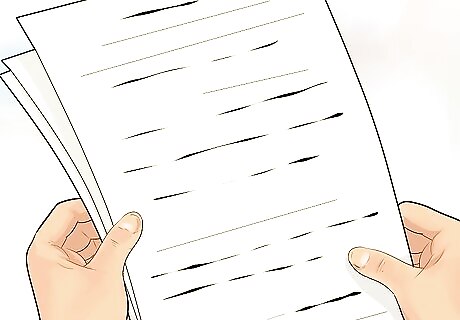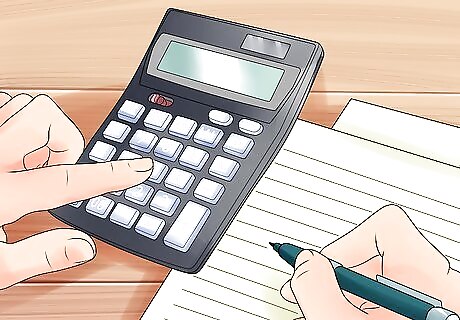
views
X
Research source
If you qualify under the chapter, you file Chapter 12 bankruptcy by submitting a voluntary petition to the U.S. bankruptcy court with jurisdiction over you and your property.[2]
X
Research source
Qualifying for Chapter 12

Review the occupational requirements. Chapter 12 bankruptcy is only open to individuals and partnerships described as family farmers or family fishermen. Partnerships and corporations are eligible to file Chapter 12 provided at least 50 percent of the stock or equity interests are owned by a single family and the stocks are not publicly traded. Additionally, the operation must be run by a member of the family, and more than 80 percent of the corporation or partnership's assets must be related to farming or commercial fishing. Spouses may file jointly if both are involved in the farming or commercial fishing operation.

Calculate your gross income. To qualify for Chapter 12, at least 50 percent of your gross income must come from your farming or commercial fishing operations. You must have regular annual income, although that income may be seasonal in nature. If you have seasonal income, it must be stable enough that you can make payments under a Chapter 12 repayment plan. If you are filing jointly with your spouse, 50 percent of your combined gross income must be attributable to the family farming or commercial fishing business. For example, if you are a farmer who has a gross income of $40,000 from farming, and your wife is an attorney who earns $80,000 a year, you would not qualify.

Total your debts. You only qualify to file for Chapter 12 bankruptcy if the total amount of money you owe falls below the maximum threshold established by law. If you are a farmer, the total amount of your secured and unsecured debts cannot exceed $3,237,000. For fishermen, your total debts must be less than $1,500,000. The same maximums apply to debts of corporations or partnerships filing under Chapter 12.

Analyze the reason for your debts. Generally, a majority of your debt must have been accrued because of farming or commercial fishing operations. If you are a farmer, more than 50 percent of your total debt must be related to farming expenses (excluding your home mortgage). For fisherman, commercial fishing-related debt must account for at least 80 percent of your total debts (also excluding your home mortgage).

Gather information. Before you begin the process of filing for bankruptcy, you should pull together all financial documents related to your farming or commercial fishing operation and your other family debts. You will need a detailed list of all of your creditors, the amount of each claim, and the reason the debt was incurred. You also should write out a detailed accounting of all of your income, include your sources of income and when it is received. Get all your monthly bills so you can itemize your regular farming or fishing and living expenses, including grocery bills, transportation, utilities, rent or mortgage statements, and taxes. If you are married, you should gather financial information for both you and your spouse, even if you aren't filing a joint petition. The court needs information about your spouse's income and expenses to accurately assess your family's financial situation.
Filing Your Petition

Complete credit counseling. All bankruptcy courts require you to complete credit counseling before filing your petition, unless you qualify for an exemption. To request an exemption, you must notify the court in writing. Typically an exemption is granted for debtors who are unable to complete credit counseling because they are disabled or incapacitated, or because they are currently serving in an active military combat zone. You can access the list of court-approved credit counseling agencies at http://www.justice.gov/ust/list-credit-counseling-agencies-approved-pursuant-11-usc-111. Once you complete the program, you must file a certificate of completion with the bankruptcy court. If you create a debt management plan during this required counseling, it must be filed with and approved by the bankruptcy court.

Fill out your voluntary petition. The bankruptcy courts have petition forms available on their websites for you to download and fill out. Although the petition and other forms are uniform across the country, you should access the form through the website of the bankruptcy court where you will be filing, as instructions and deadlines may differ. You can find the bankruptcy court you should use by entering your city, state, or ZIP code in the U.S. Courts online court locator, available at http://www.uscourts.gov/court-locator. Read the instructions that come with the form before you begin filling it out. If you plan on filing on your own, you may want to have a licensed bankruptcy attorney review your forms to make sure there are no errors.

Complete all required schedules, declarations, and statements. Your bankruptcy court's website should have a checklist you can use to determine which forms you must download and fill out for your particular case. At least four documents must be included with all petitions: a schedule of your assets and liabilities, a schedule of your current income and expenses, a schedule of any contracts or leases, and a statement of financial affairs. Additional documents may be required depending on your case and the rules of the court where you file.

File your petition. To initiate the bankruptcy process, you must take your petition and other required forms to the bankruptcy court clerk. When you file, you must pay the $275 filing fee using cash or a cashier's check or money order for the exact amount. If you cannot pay the entire fee at once, you can fill out an application to pay the fee in installments. When your petition is filed, a trustee will be appointed to evaluate your case and eventually serve as your agent to collect your payments and distribute funds to your creditors. Once you've filed your petition, the court will enter an automatic stay, which means your creditors can't sue you, garnish your wages, or even call you demanding payment of your debts. Make sure you have a copy of all your completed and filed forms for your own records. You can continue your farming or fishing operations after filing bankruptcy.
Discharging Your Debts

Calculate your disposable income. Generally your disposable income is the money left over each month after you've paid your business expenses and the expenses necessary to support your family. Once you've calculated your disposable income, you can start to build your repayment plan. You may want to meet with your trustee to work on the plan prior to your creditors' meeting. This can be to your advantage and ensure the meeting runs smoothly.

Submit your repayment plan to your trustee. You must pay all of your disposable income into your repayment plan for three to five years. One of the advantages of Chapter 12 bankruptcy is that for secured debts, such as mortgages, you only have to pay the value of the collateral that secures the debt. Any excess balance is treated as unsecured debt, and often most if not all of this amount will be discharged. Most Chapter 12 repayment plans last three years, although the court may ultimately approve a longer period for just cause. If you have outstanding child support or alimony, the plan must be for five years unless a shorter plan can cover 100 percent of those arrears.

Attend the meeting of your creditors. Your trustee will call a meeting of your creditors between 20 and 35 days after you file your petition. During the meeting you will be placed under oath and answer questions asked by your trustee and your creditors. You will be asked questions about your finances and about the terms of your repayment plan. After the meeting, unsecured creditors have 90 days to file their claims with the court, while governmental creditors have 180 days from the date your case is filed.

Attend your confirmation hearing. Within 45 days after you file your repayment plan, the bankruptcy judge will hold a hearing to determine whether your plan is feasible and meets legal standards. Your trustee and your creditors also are invited to attend the confirmation hearing. Your creditors will receive 20 days notice of the hearing from the court, and may object to the plan if they disagree with it. Generally, your plan must pass the "best interests" legal test. You pass this test if your creditors would receive at least as much money under your Chapter 12 repayment plan as they would if you'd filed for a Chapter 7 liquidation bankruptcy.

Make your required payments. If your plan is confirmed, you must make payments to your trustee, who will distribute the funds to your creditors. Making your payments will require that you and your family live on a fixed budget for the three to five years while the plan is in effect. You cannot incur any significant new debt unless you first consult your trustee, and any new debt you incur can't compromise your ability to make your payments. If your circumstances change substantially and you can no longer make your payments, you can apply with the court to have your repayment plan modified or have your case converted to a Chapter 7 liquidation bankruptcy. If you fail to make payments, the court may dismiss your case.

Receive your discharge. After your repayment plan is completed, any remaining debts will be discharged and your bankruptcy will be closed. Generally, your liability for any debts not covered by your plan will be eliminated. This means you no longer owe those creditors. Keep in mind that certain liabilities such as child support cannot be discharged.


















Comments
0 comment